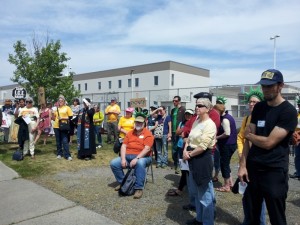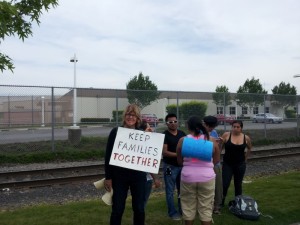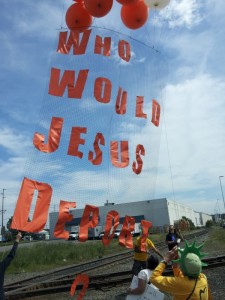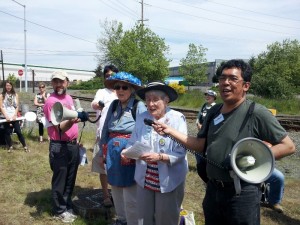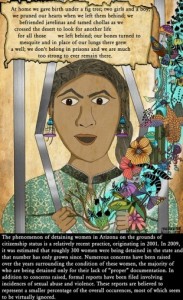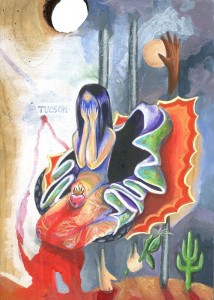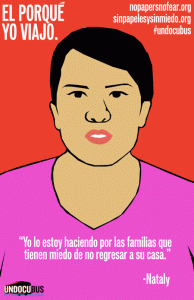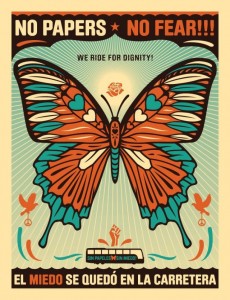Art about Detention and Immigration as a terrible new law makes its way through Congress
The Detention and Deportation system in the US is already out of control. The average population of detainees has escalated from 5,000 in 1994 to 33,000 in 2010.
The bill under consideration is mainly about defense contractors making money with more fences, drones, and other equipment.
Only 8 out of 350 detention facilities are operated by the federal government. The rest are run by private corporations like Corrections Corporation of America (CCA) and the GEO Group, Inc who are making billions of dollars. They charge us, the taxpayers, about 170. per day per detainee. Detainees are treated like criminals with jumpsuits and chains, but they don’t even have the rights of criminals to a lawyer or due process.
This process is almost invisible to the US public, although Detention Watch Network is working hard on changing that. They have a “Dignity not Detention” campaign, that includes videos and posters.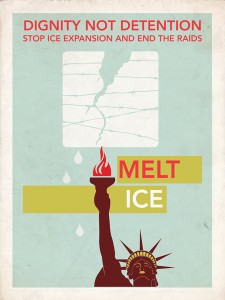
In the Northwest, we held a vigil/rally at the Tacoma Detention Facility on Mother’s Day that brought in the Backbone Campaign and the Raging Grannies, as well as more than 100 people.

In Arizona an exhibition specifically about ICE detention included some crucial statements by the artists. I am looking forward to finding more artists who address this issue. Simon Arizpe’s work is outstanding for its subtlety and sophistication, even as it presents us with a very specific and horrifying practice. He is intentionally creating something that appears to be a beautiful object that draws us in, even as he then tells us what we are looking at.
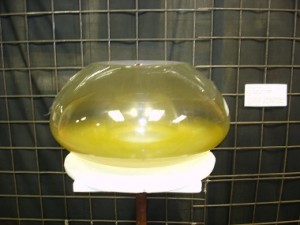
Simon Arizpe
For many detainees the first right that is stripped away from them is control of their bodily fluids. A common practice for interrogators is to deny the person water for long periods of time or conversely, to give them water and then restrict their ability to urinate.
To illustrate how politics can overshadow the basic human right of having a working, healthy body I will look to a practice used by illegal border crossers in the Sonoran dessert. These travelers are able to thwart dehydration by filtering their own urine through a simple process of two cup evaporation. I will use this same technique, which is talked about but rarely seen on this side of the border, to put into perspective the humility and isolation people go through when detained.
I will build a large-scale two-cup evaporative system 3′ x 3′ x 2′, mounting it in such a way that it appears as a beautiful design object and a working evaporator, instilling it with the weight and magnitude that the object has when it makes a life or death difference for detainees and refugees.
Shloka M. Ettna, “Women in Detention”
At home we gave birth under a fig tree. Two girls and a boy. We pruned our hearts when we left them behind; we befriended javelinas and tamed chollas as we crossed the desert to look for another life for all those we left behind; our bones turned to mesquite and in place of our lungs there grew a well; we don’t belong in prisons and we are much too strong to ever remain there.
The phenomenon of detaining women in Arizona on the grounds of citizenship status is a relatively recent practice, originating in 2001. In 2009, it was estimated that roughly 300 women were being detained in the state and that number has only grown since. Numerous concerns have ben raised over the years surrounding the condition of these women,the majority of who are being detained only for their lack of “proper “ documentation. In addition to concerns raised, formal reports have been filed involving incidences of sexual abuse and violence. These reports are believed to represent a smaller percentage of the overall occurances, most of which seem to be virtually ignored
Amy Hagemeier on the experience of women caught up in the immigration dragnet:
“The Shame” explores the unique space women occupy in immigration and incarceration. Not only do immigrant women deal with racial and economic inequality, they must also confront gender violence. This compounds the amount of abuses to their bodies and their spirits- to be separated from children, to be sexually assaulted.
“The Shame,” through the hands in the background, also acknowledges that incarceration could be extended to include the economic system that has determined what roles we are to play (ie. economic refugee), leaving us with no viable alternatives.”
Wesley Creigh
There is a desperate case for reforming the way ICE conducts their detention of migrants. Women migrants in particular make up a large, unseen population on the outskirts of our communities whose specific medical, emotional and familial needs are not being met. As women continue to be subjected to these indefinite and non-criminal incarcerations families will continue to be separated and children will continue to be caught up in the equally bureaucratic and convoluted CPS (Child Protective Services) system. The trauma that occurs from these separations and imprisonment is long lasting and severely damaging. Yet this is something that we are ignorant about because we do not have to face it at all. ICE has made sure this population is virtually invisible to us. The more we can inform ourselves the more we can begin to struggle for reform.
Julio Salgedo has created a series of posters that demonstrate a sophisticated graphic aesthetic as well as a clear statement of the issues
Here is another “Why I travel” ” I am here for the families who are afraid to leave their house.” This is part of the nopapersnofear campaign.
“Fear is left on the road”
The monarch butterfly that migrates throughout North America from Mexico to Canada is the symbol of this movement.It is an ancient symbol of freedom
It has caught on with many people. Here are some children from May Day march in Seattle
The description below of the current disastrous bill is from the Detention Watch Network website where there is a wealth of useful information.
“Rep. Gowdy’s SAFE Act Will Lead to Massive Detention Expansion (WASHINGTON) – The House Judiciary Committee is expected to begin markup of Rep. Trey Gowdy’s (R-SC) Strength and Fortify Enforcement (SAFE) Act legislation, H.R. 2278, on Tuesday, June 18.
If enacted, the SAFE Act will dramatically increase detentions and deportations and create an environment of rampant racial profiling without fixing the immigration system’s fundamental problems.
The SAFE Act would do the following:
Authorize excessive spending increases to build and expand detention facilities across the country. (H.R. 2278: Title I, Sec. 107)
Undermine individuals’ due process and equal protection rights under the law by allowing for indefinite detention and significantly increasing the number of immigrants subject to mandatory detention without the right to a hearing before an immigration judge. (H.R. 2278: Title I, Sec. 108, 111; Title II, 301, 310; Manager’s Amendment)
Undo hard-won progress to improve conditions for immigrants in detention by reverting to minimal U.S. Marshals Service custody guidelines. (H.R. 2278: Title I, Sec. 108)
Funnel more immigrants into the detention and deportation system by expanding the grounds of deportability and by authorizing states and localities to create and enforce their own immigration laws.
“The SAFE Act resurrects the much discredited Sensenbrenner bill from 2005 and proposes an extreme departure from existing immigration law. If passed, the SAFE Act would be disastrous for the bipartisan efforts to enact just immigration policies,” said Andrea Black, Executive Director of DWN.
“Not only will it expand detention, it will result in the prolonged and unconstitutional incarceration of thousands of people, under inhumane conditions, without any safeguard of their civil and human rights.”
Detention Watch Network calls on Congress to vote against the SAFE Act and instead to repeal mandatory detention and reduce the unnecessary, inhumane, and wasteful detention of immigrants. Until immigration reform is enacted, DWN calls on President Obama to put a moratorium on detentions and deportations and stop the unnecessary separation of thousands of American families.
This entry was posted on June 20, 2013 and is filed under Art and Activism.


